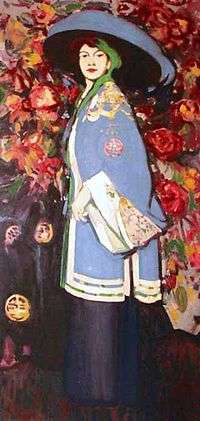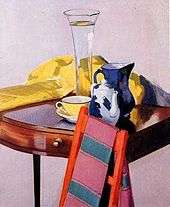Scottish Colourists
The Scottish Colourists were a group of four painters, three from Edinburgh, whose Post-Impressionist work, though not universally recognized initially, came to have a formative influence on contemporary Scottish art and culture. They were Francis Cadell, John Duncan Fergusson, Leslie Hunter and Samuel Peploe.[1]

These four artists had much in common, hence the appellation ‘Scottish Colourists’. The art historian Duncan Macmillan wrote [2]
“In the end the justification for continuing to treat them separately though is their collective achievement and international reputation that they have earned as four of the most gifted painters of their generation in Britain.”
The expression ‘Scottish Colourists’ according to Macmillan may have first been used as early as 1915 in the Studio magazine. Its specific association in print, again according to Macmillan, seems to have been first used by T J Honeyman [3], the art critic and director of Glasgow Art Gallery, in his book Three Scottish Colourists published in 1950. Why he did not include Fergusson at this point is unclear, but Fergusson seems to have soon been accepted into this group of artists.
The four artists did in fact exhibit together, for the first time in 1924 in Paris at an exhibition at the Galerie Barbazanges entitled ‘Les Peintres de l’Ecosse Moderne’ (Bilcliffe) .[4] The following year, they showed together at an exhibition in London at the Leicester Gallery.
History
The Scottish Colourists combined their training in France and the work of French Impressionists and Fauvists, such as Monet, Matisse and Cézanne, with the painting traditions of Scotland.[5] A forerunner of this movement was William McTaggart (1835–1910), a Scottish landscape painter who was influenced by Post-Impressionism. He is regarded as one of the great interpreters of the Scottish landscape and is often labelled the "Scottish Impressionist".
Largely recognised as the leading figure of the group was Samuel Peploe. The other Scottish Colourists were Francis Cadell, John Duncan Fergusson and Leslie Hunter. They "absorbed and reworked the strong and vibrant colours of contemporary French painting into a distinctive Scottish idiom during the 1920s and 1930s".[6]

Their subject matter is often considered conservative compared to their French counterparts, since much of it consisted of island landscapes, Edinburgh interiors and fashionable models;[6] their style was confident and vibrant.
The Scottish Colourists were internationally known during their lifetimes but their work fell out of favour by World War II,[7] until they were rediscovered in the 1980s and subsequently played an influential role in the development of Scottish art.[6]
Their work is featured in the Aberdeen Art Gallery in Aberdeen, Scotland; the J. D. Fergusson Gallery in Perth, Scotland; the University of Stirling, Paisley Museum and Art Galleries and the Scottish National Gallery of Modern Art in Edinburgh. Some of Leslie Hunter's paintings can be seen in the Kelvingrove Art Gallery. The Kirkcaldy Museum and Art Gallery is said to house the largest collection of works by Peploe and McTaggart. From 18 October 2019 - 1 February 2020 Abbot Hall Art Gallery, Kendal, hosted an exhibition of the Scottish Colourists largely based on works from the Fleming Collection.
Notes and references
- McEwan, P J M, The Dictionary of Scottish Art and Architecture, 2nd Edition (2004), Glengarden Press, Ballater, 620pp, over 12,000 references and bibliography.
- Macmillan, D, Scottish Art 1460 – 2000 (2000), Mainstream Publishing, Edinburgh and London, 464pp, 369 illustrations, a magisterial work, see Chapter XVII The Colourists.
- Honeyman, T J (1950), Three Scottish Colourists, Thomas Nelson & Sons Ltd, London.
- Billcliffe, R, The Scottish Colourists (1989), John Murray, London, 176pp with 136 colour plates.
- "The Scottish Colourists". Explore Art. Retrieved 2012-10-26.
- "The Scottish Colourists". Visit Scotland.com. Archived from the original on 2008-04-29. Retrieved 2008-06-25.
- Kram, Miriam (July 2000). "The Scottish colourists". Magazine Antiques. Archived from the original on 2009-10-05. Retrieved 2008-06-25.
- Book: The Scottish Colourists 1900–1930 Philip Long and Elizabeth Cumming
External links
- National Galleries of Scotland: F.C.B. Cadell
- National Galleries of Scotland: John Duncan Fergusson
- National Galleries of Scotland: George Leslie Hunter
- National Galleries of Scotland: Samuel John Peploe
- Portland Gallery Portland Gallery in London specialise in the work of the Scottish Colourists
- Major Cadell exhibition at Portland Gallery in September 2010 to coincide with the re-publication of the book on Cadell by Tom Hewlett